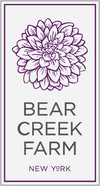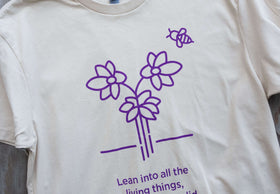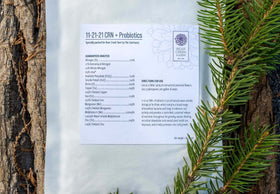Few flowers seem to catch that late-summer-into-early-fall shimmer quite like a dahlia. In an extraordinary nod to the ever-dynamic wonders of nature, the subtle hues of dahlias – throwing royal to lavender purples, and coral to salmon -- often do shift within their growing season. A red will dahlia will deepen to amplify the cerulean blue, robin-egg blue of an autumn sky. An orange dahlia bloom will wake up the no longer new-made soft green grass to remind that the deeper green is lovely just the same. (Your eyes are not playing tricks.)
Together, dahlias join a crescendo of choral colors that have stored their most extravagant expressions to align with the palette of autumn. Like an unexpected fall raspberry, dahlias are the beginning of a kiss goodbye to summer – as the evenings cool and things begin to settle.
Dahlia growers want to achieve just this sort of floral bounty. But how? Here are some basic “rules.” (And please, remember that at Bear Creek Farm, “rules” are more like guidelines with which to experiment and play. We all learn by doing. I am here to remind you that the best laid plans may not go as planned, but that the lessons learned may lead you to garden paths you’d never otherwise have discovered about nature, and one's own place within it.)
When should I plant my dahlias?
Remember that Bear Creek Farm offers an expert streaming video about storing dahlia tubers. To learn more or to purchase, click here.
- It is the temperature of the soil, not the temperature of the air, that is the critical first step to planting a healthy dahlia.
- As spring comes back, and the sun hints at heat, I see you there. You have a trowel in your hand, eager to roll up your sleeves. Wait. Do not rush. (I know how hard this is, but if you plant too early your tubers may just rot.)
- You’ll want the soil temperature to be 60 degrees or warmer.
- To determine whether your soil is ready, buy an inexpensive soil thermometer, and test the soil mid-morning.

Where should I plant my Dahlias?
- Dahlias need generous sun exposure.
- Choose a place in your garden that receives 6 to 8 hours of sun a day.
- If you live in a very hot climate, a little afternoon shade can’t hurt.
- If you’re struggling to find a patch of land that gets full sun, try the lower growing or dwarf dahlias.
What sort of soil should I have?
Assessing your soil conditions is important. Keep in mind, you will want your soil to be:
- Slightly Acidic. Aim for a PH level of 6.5 – 7. Add lime to increase the level, or sulfur to decrease it. If you have questions about adjusting these levels, ask someone knowledgeable for help at a nearby nursery.
- Well-drained Soil. Avoid planting dahlias in soil that pools after it rains. Plant where soil is likely to absorb water; poor drainage can rot tubers.
- Prepare Your Soil. Give your soil a boost of nutrients early on with a winter or spring cover crop, when possible.
- Ensure Soil is Free of Herbicides. Even if an herbicide claims to be safe for flowers, don’t use it. (This includes any new topsoil you may bring to your property.)
- Always Hand Weed. Never use weed killers. Weed killers may kill weeds, but they also kill your dahlias. Hand weeding is - hands down - the best way to keep weeds out of your garden beds.
- Consider Your Climate. If you live in a hot climate, you can consider mulch to help retain moisture throughout the driest parts of the summer and keep dahlias cooler.

How do I plant my dahlias?
- *Pro-Tip* DO NOT OVER-WATER. As you plan your dahlia bed, always keep in mind that over-watering is one of the main reasons dahlias fail to bloom.
- Trimming. If your tubers have any sprouts attached to them that are longer than 1”, carefully trim them back to just 1”.
- Spacing. Plant your tubers sideways with the growing eye facing up in holes that are 6 inches deep, and 18-24 inches apart, depending on the size (how big) the varietal you’re planting. You will want to allow sufficient space for healthy growth.
- Staking. If you do wish to stake, insert your garden stakes right next to each tuber. Any kind of stake is fine (metal, wood, plastic etc.). It is best to stake before they sprout.
- Use some bone meal. Go ahead and throw in a small handful of bone meal—it’s a great fertilizer and source of phosphorus and protein. (That said, be careful if you have pets, as dogs may dig it up.)
- Don’t cover your garden bed. Gardeners are often taught to use mulch or bark dust. This won’t work well for dahlias because the sun keeps the soil nice and warm. However, please note exceptions for very southern states.
- Add snail and slug bait. For specific recommendations, ask a knowledgeable local nursery for guidance. Iron phosphate is an excellent, organic alternative, safe for children and pets.
- Know your climate. Unless you live in a hot climate, you don’t need to start watering until after your tubers have sprouted, which will be in 3 to 10 weeks. In hot climates, soil should be slightly damp at planting to get your tubers going.

Can I grow dahlias in a container?
- Short answer is sometimes. It is worth noting, however, that dahlias do grow best in the earth.
- Select your dahlia knowing that you will be growing in a container. Some varietals grow well in pots. For urban dwellers wanting to cultivate beauty, but who lack access to that necessary patch of earth, focus on low growing and dwarf dahlias. (These varietals don’t need as much space and soil.)
- Use the right-sized pot. If you are growing these dahlias, a five to seven gallon pot will do just fine.
- Use the correct soil. Aim for two parts garden or topsoil, and one part potting soil. Be sure the potting soil is not sterilized.
- Consider sourcing your dahlia tubers from a farm other than Bear Creek Farm. At Bear Creek Farm, we want all growers to succeed. Therefore, in the spirit of full disclosure, we want to be clear that Bear Creek Farm dahlia varietals are not container lovers. This is due to their larger size, and to their collective free spirit. Still, we are there for anyone, anywhere who wants to brighten a city street with a window box full of unexpected color. Consider alternative products, such as our line of seeds.
How often should I water my dahlias once they are in the ground?
- After your dahlia’s sprouts are just above the ground, they will need a deep watering 2 to 3 times a week.
- You will want to deliver enough moisture to reach your planted tuber.
- Remember, you only need to water unsprouted tubers if you live in hot, dry climates like Texas or Southern California: in this case, water lightly once or twice a week if soil is completely dry.
Should I fertilize my dahlias?
- If you choose to use a fertilizer, go for low nitrogen and high in potassium and phosphorus, something like a 5-10-15 or 5-10-10.
- Fertilize within the first month of planting, then repeat again 3 to 4 weeks later.
- Don’t overdo it.

How should I pinch my plants?
- Pinching means that you snip the top of the main stem.
- Once plants are between 9" and 18" tall is the time to pinch, which is snipping off the top 3"-4" of the central shoot or terminal bud.
- This will help bloom a bushier plant with more flowers.
- Pinching provides increased stem count, low basal branching, and graceful stem length.
- Be sure you cut at least above the third set of leaves.

How should I dig and store my dahlias?
- After your dahlias have turned black from frost, wait two weeks for them to grow their "winter skins."
- Cut the stems at about 6 inches and carefully dig out the sizable tubers.
- Wash off the dirt and leave them in the sun to dry.
- Then pack them in some peat moss, sand or sawdust in a paper bag or box, but without air spaces around them.
- Store them in a cool, dry area (not a freezer) until you’re ready to plant next spring.

How do I divide my dahlias?
- Cut your tuber clump with a sharp knife to separate out the tubers.
- Each one must have an “eye” (growing point, which is the sprout for next season) located in the center stalk to grow.
- You can do this in the spring or the fall. If you can’t see the eyes (and not all tubers have one), try dividing the clump into halves or quarters.
Gifts for Flower Growers (including yourself)
- Growing flowers lifts the spirit, but it can be daunting to know where to begin. Gift a friend (or gift yourself) a way to just start. (The longest journey begins with the first step.) Consider a surprise gift card to embolden someone who seems both tempted, but unsure of where to begin.
- Invite a friend to join you at Dahlia Workshop at Bear Creek Farm. We offer several workshops, each with a different emphasis, including how to care for Dahlia tubers, a fall half-day workshop on caring for Dahlias in general, and our signature Farm Tour and Dahlia workshop. When you and a friend sign up together, we will extend a 10% off discount to both of you. Email us at info@bearcreekfarm.com for more information.
- Purchase a Dahlia flower share. If you (or someone you wish to honor) loves flowers, but just can’t quite see planting a garden this year, take this year to draw inspiration for next year. Consider purchasing a share in our Dahlia CSA. (Please note: We offer five convenient pick-up locations.)
- Stream our Dahlia expertise. Perfect for Dahlia lovers who are not local to Bear Creek Farm or the environs, we remind, once more about our singular tuber to bloom streaming video. To learn more, click here. When starting anything, confidence is key.
Now that you've finished reading this article, you should check out our tulip planting primer, dahlia growing guide, and cutting guide for dahlias. And if you're shopping for dahlia tubers, make sure to check out our giant dahlia tubers (10"+ blooms), micro dahlia tubers (under 2" blooms), dark pink dahlia tubers, dark red dahlia tubers, and bicolor dahlia tubers.





I saw you with the dilahias on visiting Martha Whites farm program on Roku and I really enjoyed the learning program
Thank you for the info🌸